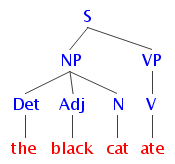Course:LING300
| LING300 Syntax (Studies in Grammar) | ||
|---|---|---|

| ||
| Course Info | ||
| Class schedule: | Tuesday/Thursday, 9:30-11:00am | |
| Virtual Classroom: | Collaborate Ultra | |
| Linguistics Lounge: | Tu&Th, 11.00-11.30 Collaborate Ultra (or by appointment) |
M&Th, 4.00-4.30 Collaborate Ultra (or by appointment) |
| Instructor: | Rose-Marie Déchaine e-mail instructor | |
| TA1: | Rose Underhill e-mail TA1 | |
| TA2: | Ife Adebara e-mail TA2 | |
| Friday Tutorials: | T01, 1.00-2.00 Buchanan B306 | |
| Course Syllabus: | Ling300 syllabus | |
| Wikipedia Project Page | ||
| Ling300 Wikipedia Project Page | ||
| Course Lessons | ||
| Background Materials | ||
Syntax is the branch of linguistics that deals with the structure of sentences. Syntax, understood as the (implicit) knowledge that speakers have of the sentence structure of their language, is a core component of the human language faculty, and interfaces with all aspects of grammar, and ultimately human cognition. Words are the building blocks of syntax; consequently, syntax and word-level processes (morphology) go hand-in-hand. Syntax is shaped by, and shapes, semantics: lexical meaning constrains syntactic structure, and syntactic structure in turn constrains rules of semantic composition. Syntax also shapes phonology, as the output of syntax is the input for rules of phonological interpretation. We will therefore be concerned with: (i) what the study of sentence structure reveals about the organization of the grammar (understood as a form of cognition); (ii) how syntax interfaces with other components of the grammar (especially, phonology, morphology, and semantics).
Goals and Objectives
There are two primary learning outcomes:
- Use hypothesis-testing to identify syntactic relations, with a focus on:
- detecting syntactic relations (“What’s out there?”)
- Categories: How do linguists detect the syntactic atoms of language?
- Constituents: How do linguists detect the structure of a sentence?
- Selection: How do linguists detect the dependency relations that hold between constituents?
- modeling syntactic relations (“How do linguists model what’s out there?”)
- Storage: How is information about syntactic atoms is encapsulated in the lexicon?
- Computation: How are syntactic atoms assembled into complex units via recursive structure-building?
- Representation: How do syntactic atoms generate labelled trees?
- Working collaboratively, contribute to knowledge dissemination by developing a Wikipedia entry in one of the following four themes:
- Theme A
- General Syntactic Theory
- A1. Bare Phrase Structure; A2. Biolinguistics; A3. Category-neutral roots; A4. IDLP format; A5. Minimalist theory; A6. Minimality
- Theme B
- Verbal Syntax
- B.1 Syntax of C: clause typing; B.2 Syntax of T: tense-marking; B.3 Syntax of Aspect: aspect-marking; B.4 Syntax of V: vP shell; B.5 Syntax of event structure: events versus states; B.6 Syntax of valency: intransitive, transitive, ditransitive; V.7 Syntax of voice: active, passive, middle voice
- Theme C
- Verbal Syntax
- Lexical semantics, Head parameter, Subject parameter, Theta criterion
- Theme D
- Binding Theory
- Bound variable pronoun, Logical Form, Logophoricity, PRO
Textbook information, websites, additional resources
- Textbook:
- Sportiche, Dominique, Hida Koopman & Edward Stabler. (2014) An Introduction to Syntactic Analysis and Theory (First Edition). Wiley-Blackwell. [SKS]
- Background material:
- Sobin, Nicholas. (2011) Syntactic Analysis: The Basics. Wiley-Blackwell. [S=Sobin]
- Carnie, Andrew. (2012) The Syntax Workbook. Wiley-Blackwell.
- Wikipedia project: see course Wiki for additional resources
- General Intro https://en.wikipedia.org/wiki/Wikipedia:Tutorial
- Article wizard https://en.wikipedia.org/wiki/Wikipedia:Article_wizard
Schedule
| Date | Assignment |
|---|---|
| Th 11 Sept | Problem set 1: Constituency & X-bar Theory (2%) |
| Th 18 Sept | Milestone 1/individual: Wikipedia conventions (5%) |
| Th 25 Sept | Problem set 2: Binding & Locality (2%) |
| Th 02 Oct | Milestone 2/group: Annotated bibliography (5%) |
| Tu 07 Oct | Mid-term exam (in-class; 15%) |
| Fri 17 Oct; Mon 20 Oct | Round 1 Content Meetings |
| Tu 21 Oct | Self & peer assessment 1 (formative) |
| Wed 22 Oct; Fri 24 Oct; Wed 29 Oct | Round 1 Technical Support Meetings |
| Mon 27 Oct | Problem set 3: Movement (2%) |
| Fri 31 Oct; Mon 03 Nov | Round 2 Content Meetings |
| Tu 04 Nov | Milestone 3/group: Review other Wikipedia projects (5%) |
| Wed 05 Nov; Fri 07 Nov; Wed 12 Nov | Round 2 Technical Support Meetings |
| Fri 07 Nov | Problem set 4: Detecting structure (2%) |
| Th 13 Nov | Milestone 4/group: Submit for peer review for "Good Article" status (5%) |
| Th 20 Nov | Problem set 5: Syntactic atoms (2%) |
| Th 27 Nov | Milestone 5/individual & group: Reflective essay & Nomination for "Featured Article" status (5%) |
| Th 04 Dec | Final Exam (take-home; 25%) |
| Tue 09 Dec 3.30-6.30pm (during final exam period) | Location TBA, Oral presentation (5%) |
| Th 11 Dec | Final posting of Wikipedia article (20%) |
| Fri 12 Dec | Self & peer assessment 2 (summative) |
| Mon 15 Dec | Cut-off date for credit for Linguistics Outside the Classroom activities |